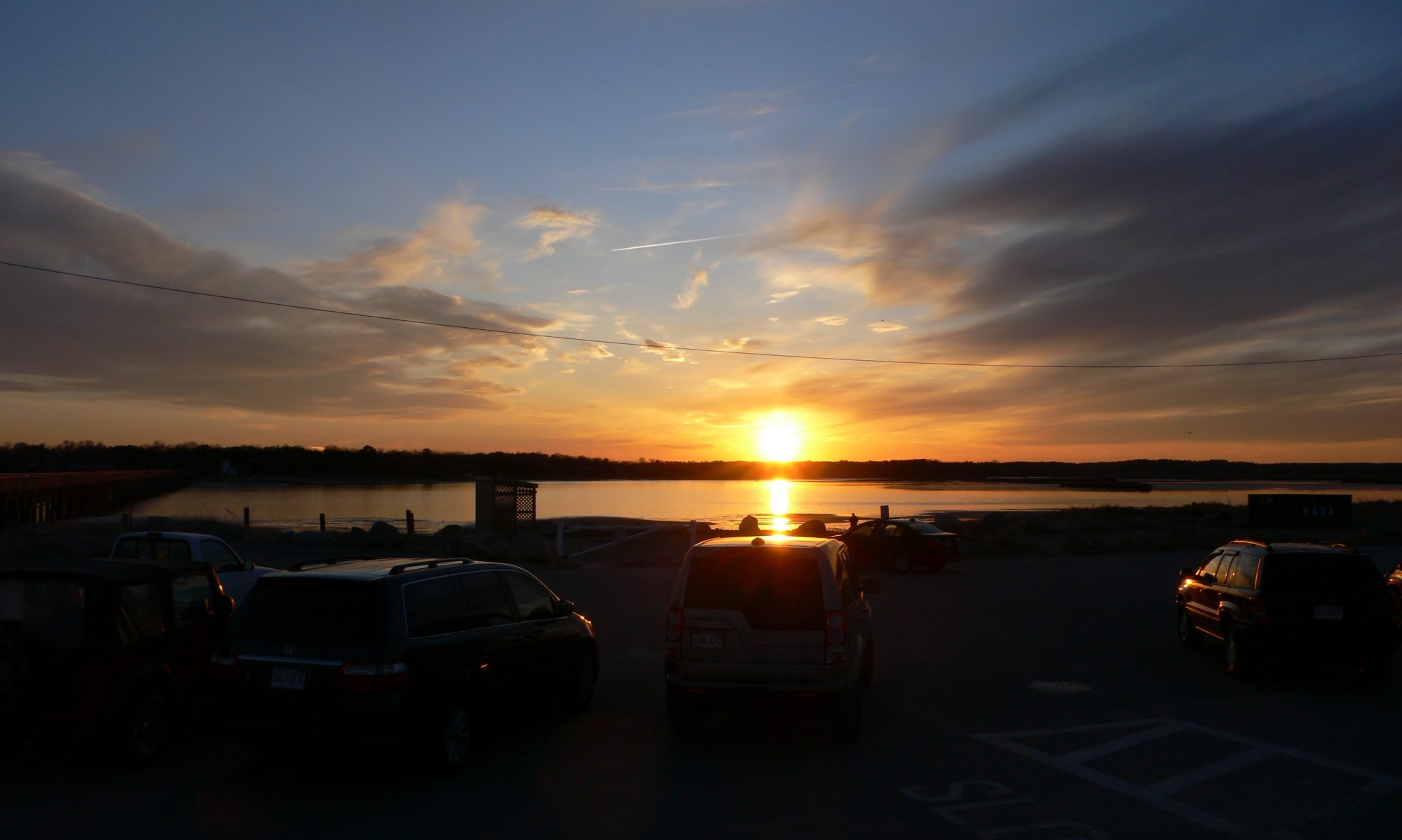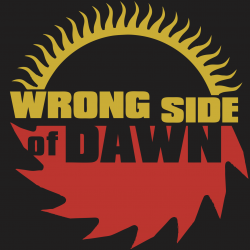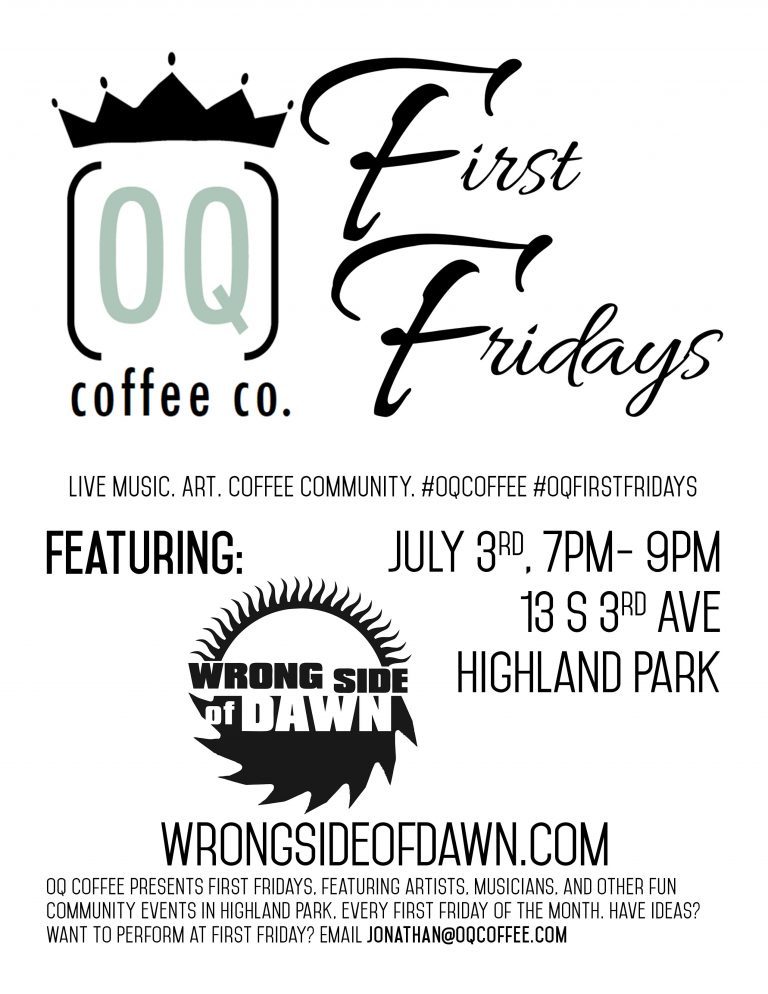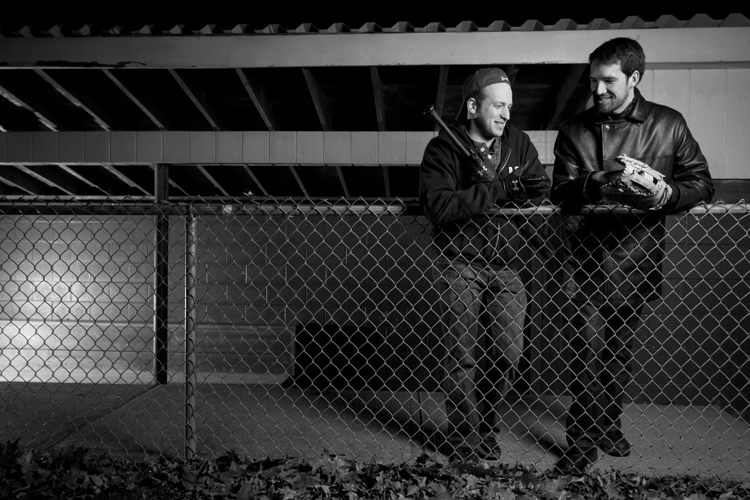Acoustic Show at OQ Coffee

Wrong Side of Dawn will be playing a free acoustic show at OQ Coffee in Highland Park on Friday July 3rd, 7-9pm. Come join us and support sustainable coffee, local business, and live music! There are board games, paintings by local artists on the walls, and chairs with umbrellas on the sidewalk so you can enjoy the lovely weather outside. We’ll be selling our t-shirts and CDs, so if you’ve been dying to wear a WSD logo on your chest, now’s the time to try it on 🙂 Who could turn down two hours of our groovy tunes? Only the ungroovy, and you don’t want to be ungroovy, do you? You can RSVP at the Facebook event if you like.
Antes De Dormir
Brazilian filmmaker André Aoki has included our song “Running Scared” in his latest short, “Antes De Dormir”. Check it out! Our song appears around 8:30, about halfway through.
The Making of the “Baseball” Music Video
It’s here! Just in time for the finish of the Major League pennant race, Wrong Side of Dawn has released the “Baseball” music video! But the video isn’t directed at World Series champions. This one is for the rest of us.
WRITING “BASEBALL”
“Baseball” is actually partly the musical daughter of “The Grinder’s Tale” (another song about the effort to make a living by playing a game). It’s origins are in this Music Theory 101 project that I wrote at age 18 (please excuse my amateurish violin-playing on the melody–the composition is good, but the execution is not). I’d recently written the guitar riff that would become “The Grinder’s Tale.” It was one of the few riffs of mine that I really liked. When my music theory class was given the assignment to finish the semester by writing a classical composition, my goal was to create a classical piece based off of my favorite original riff.
You’ll notice the similarities to “The Grinder’s Tale” in the opening motif. But as classical pieces often do, I let the melodies and harmonies venture off into other places. In particular, I latched onto the little transition back to minor that you hear at 2:04 to 2:07.
So I decided to reverse the process I’d used to write this song, and create a rock version of that classical section! The melodies and chords that you hear in the “Baseball” bridge riff (2:31 to 2:51 of the music video) are based off that portion of my music theory project. The chords became the song’s chorus.
The opening riff was something I thought of mentally while in the shower. Based around an F# octave, I harmonized it with 2 otherwise-unrelated chords that both contain F# (D major-add9, and B7).
Because of the lineage from “The Grinder’s Tale,” I initially intended to write a song called “The Grinder’s Tale Part 2,” and use this as its musical base. However, I eventually decided that the world has enough poker songs for now. Besides, despite being one of the best, and definitely the most heavily-promoted, song from Stay Awake, “The Grinder’s Tale” and its poker theme didn’t exactly vault us into Miley Cyrus-level stardom. So maybe it was time for a new direction.
The lyrics stem from a conversation I had with my brother in my parents’ garage. We were commenting on the amount of boys who dream of being professional athletes, compared with the microscopic percentage that actually make it to the highest professional league. I observed, “Almost every man in America is some boy who failed to make it as a professional athlete. We all have that in common.” In the song, this became shortened to: “Every man is just a boy who never made it in baseball.” And that’s where the lyrics began.
“BASEBALL,” THE VIDEO
The “Baseball” music video was filmed and directed by Adam Chinoy, the man behind our “Crossing the Bar” video. But while “Crossing the Bar” was shot in a single morning, “Baseball” was a more ambitious project.
The “live” footage of the band was actually taken on two separate nights. Any close-ups of the band were filmed on the Tuesday before the “Baseball/If I Ever Loved” release show. The wide shots (where you can see the audience) were filmed at the show itself, on Friday. It was a simple trick to create the illusion that all the footage is from a single live performance… All we had to do was wear the same clothes both nights.
From there, we went into several rounds of “this needs something more.” For a song about baseball, the live performance footage was lacking in, well, baseball. To fix this, I talked to a family that I coach swimming with. In addition to swimming, their son also plays baseball. So we asked if we could attend one of his games and get some Little League baseball footage. Andrew, our child star, had the additional advantage of bearing certain physical similarities to me (mainly, he’s a white guy with blond hair). This allows the video to be interpreted as us playing essentially the same person. He’s the Little League ballplayer with the potential to make the majors. I’m the adult former ballplayer who never actually got there.
Nelson, Adam and I arrived early to film the batting practice scene you see at the end of the video. And while I insist that I can hit a ball over a 305-foot fence, I’ll admit that the ball you see me hit in the video didn’t actually travel that far. My “near-miss home run” was actually tossed against the wall by hand.
(Some time had passed since our initial performance footage, and that time included a haircut for me! You’ll notice that what’s hiding under my Yankee cap doesn’t exactly match what you see on the stage portion.)
Finally, we decided to add a little bit of a narrative element to the video, via the text portions shown during the instrumental sections. Told through statistics, it’s meant to underscore the essential theme of the song: big dreams are available to everyone, but only a few people fully achieve them. And most of us manage to build a decent life despite the fact that we fall short of greatness.
(Some people have asked about the exclusive focus on “American” baseball players. There are two reasons for this. The first is statistical consistency. We combined an estimate of how many American boys begin playing baseball each year with how many new Major League careers are created every year. If we started with Americans, we must end with Americans, and that requires an acknowledgement that men from other countries are competing for the same finite number of jobs. Also, in a song that mentions “American dreams” in the chorus, we wanted to keep the focus on the “American” element of its theme: the idea that an ordinary American boy can grow up to become rich by playing “America’s pastime.”)
Anyway, without further delay, go check out the video!
Nelson and Brian perform “Baseball” on BettingAgainstMyself.com
I had Nelson appear with me on my sports show at BettingAgainstMyself.com (view the original post here) to try and take advantage of his lack of football expertise. My football knowledge has not served me well recently, so we decided to make some NFL picks in a decidedly non-football-related (and sometimes funny) way.
We ended with a short discussion of baseball, followed by the song “Baseball.” If you want to see the whole thing, go to the blog post linked above. Here’s just the musical ending. This exclusive live acoustic version features our producer (my brother Andy) playing harmonica off-camera. I’m pretty sure it’s his first public performance!
And don’t forget to download “Baseball.”
Greatest Rock Band 3 song ever is now available!!!11!1
Did all your Christmas presents suck? Nothing as exciting as the Rock Band 3 you got last year? Of course, you’ve already played all your favorite Rock Band tracks so much that you’ve gotten tired of them. Well, the perfect solution is to reinvigorate your Rock Band experience by downloading “The Grinder’s Tale,” now available on the Xbox360 Rock Band Network for the low, low price of only 80 MSP ($1)! (Make sure you go to the “Rock Band Network Music Store” on your game menu, rather than just “Rock Band Music Store.”)
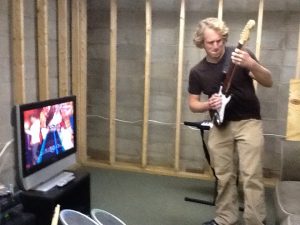 We owe this track’s availability to the genius of the guys at Rhythm Authors, who charted the song for the game. (Going through this process has given us new vocabulary words. “Charting” is what you do to program a song for the game. Those little colored dots on the fret board that tell you what notes to play are called “gems.”) It’s a hell of an undertaking when you think about it.
We owe this track’s availability to the genius of the guys at Rhythm Authors, who charted the song for the game. (Going through this process has given us new vocabulary words. “Charting” is what you do to program a song for the game. Those little colored dots on the fret board that tell you what notes to play are called “gems.”) It’s a hell of an undertaking when you think about it.
We sent them the stems for each track in the song… essentially turning a 7-minute song into twelve 7-minute songs consisting of only one instrument or voice each. Then, they have to match every note we played with a gem that will appear at the right point in the game. If you miss a gem, that instrument will cut out for the duration of the note you missed (this is really the essence of the whole game, isn’t it?). It’s even more precise with the vocals and keyboards, which need to match up with the exact notes of the performance. Everything needs to fit within standards that make the song playable in the game. And of course, this has to be done 4 times for every instrument (for the Easy, Medium, Hard, and Expert levels of game play). The little avatar guys on the game are animated to “play” the song on screen. If that wasn’t enough, due to the fact that we had to chop the song up before sending it to them, the entire thing needs to be remixed and remastered. They do this all without an up-front fee, instead taking a percentage of the earnings. So if you won’t buy the song for us, at least buy it for them!
So far, over 200 people have played the song, including myself, and I have to admit that I’m nowhere near the top of the guitar leaderboard… Somehow I can’t hit 100% notes on the game for a part that I wrote and played, yet other people can!
https://www.youtube.com/watch?v=lEK3R7Mgqgc
Hear are some videos we found posted on YouTube by people who’ve played the song:
—All instruments (about 1,500 views of this video so far)
—Bass
—Keys and Guitar (same video here as well, but no one’s gotten to showing us those “Pro Keys” yet!)
So try it for yourself, and if you can get 5 stars on Expert for Gray’s crazy ass keyboard part, I will personally reimburse you the $1 cost of the download!
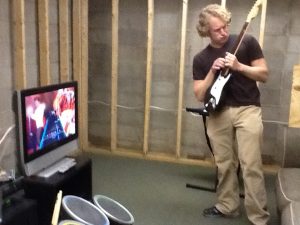 (If you aren’t into video games, you can always just get the song itself…)
(If you aren’t into video games, you can always just get the song itself…)
“Crossing the Bar” backstory
The idea for recording “Crossing the Bar” with Nelson came to me while I was taking a college course in British poetry. At the end of class one day, the professor said she was going to read the poem out loud, then play a recording of the poem set to music (she was referring to the version by Salamander Crossing). After reading the poem, the professor expressed disappointment that we were out of time, and she would be unable to play the recording today.
I was not familiar with the poem before taking the class, but I really enjoyed hearing the sound of the poem read aloud. So I was very excited to hear a musical version, and I got the Salamander Crossing song off of iTunes that night. Though their version is pretty, it wasn’t exactly what I had expected. The poem was greatly modified. I like Tennyson’s poem partly because it sounds so rhythmically natural, despite the fact that the syllables in each line don’t seem to follow a clear pattern. Salamander Crossing’s version seems to neutralize this element through the way the singer holds out certain notes, or doesn’t hold them out; she makes everything seem even. Also, to make it more pop-song-like, the order of the stanzas is changed, and the final line of each stanza is repeated to form a sort of chorus section.
At that point, I set out to make a “Crossing the Bar” song which sounded more like what I had hoped to hear. I wanted to have fewer modifications, and sing the poem in basically the same rhythm in which it is spoken.
The guitar chords came from two already-existing songs. The first half (in which you hear Nelson sing) is set to a guitar part from “Flight II.” It’s an instrumental song written by Nelson, but he had been musing about trying to put words to it. I wanted to see if “Crossing the Bar” fit. It did. The second half of the poem (in which you hear me sing) is sung over the guitar from “Where Is Bobby McGee?,” which I had written just a couple days before. Again, it just happened to be a riff that I was playing around with at the time, and I decided to squeeze it in. I recorded a quick demo and brought it into class. It scored big points with my poetry professor.
When we got into the studio with our session musicians (guys who outclass us by several leagues…), the song really seemed to come alive even more. Bassist Andrew Angelin came up with a bass introduction using a “watery” chorus effect, which fits the words perfectly. Karen Rustad, Nelson’s girlfriend at the time, attempted to find a good melody for synthesized strings, but we thought it sounded better on piano. Eventually, the piano part was played by Gray Reinhard, who is a magician with keys. Based off of Karen’s melody, he plays a piano coda which breaks my heart every time I hear it.
The music video is pretty self-explanatory. Adam Chinoy did a great job putting it together as director, editor, cameraman, and probably a few other things. We shot the video at sunrise, which might seem a little counterintuitive considering the first word of the poem is “sunset,” but since we live on the east coast, morning was the only time we could get the effect of the sun over the ocean. Hope you enjoy it!
See the music video here: http://www.youtube.com/watch?v=FjY-0p_jE1k
You can get the song here: http://music.wrongsideofdawn.com/track/crossing-the-bar
Official “Crossing the Bar” music video released
We now present to you the official music video for Crossing the Bar, from our 2010 album Stay Awake! Directed by Adam Chinoy, starring me and Brian, filmed at Monmouth Beach, NJ.
We had to wake up in the early AM and drive to the beach in the dark before the sun came up. We couldn’t film a sunset and achieve the same dramatic effect, because the sun rises in the east and sets in the west, and therefore on the east coast the sun rises over the water and sets over the land. To get the sun over the ocean, we had to film at dawn. It was totally worth it, the colors that day were amazing.
There is one thing that we had to cut from this video, regretfully. We had originally planned on making paper boats, placing them in the water, and then filming them floating out to sea. Sadly, if the paper boats were released too close to shore, they were swamped by waves in seconds. If they were placed too far away from the land, they were too small and hard to see, no matter how much Adam zoomed his camera. After showing the shots to our friends and having them fail to identify the dots in the water as paper boats, we gave up. Adam saved the day by discovering a sailboat on the horizon in several of the shots and emphasizing that instead.
We plan to make more ambitious music videos in the future, but for what it is, a simple performance video, we’re very happy with the results. Sunrise over the ocean is pretty.
We’ve filmed a music video! But this isn’t it.
Last week we succeeded in filming a music video for the first time, after over a year of false starts and the universe conspiring against us! It will be for our song Crossing the Bar. While we wait for the video to be edited into its final form, I thought I would give you a little teaser. Here is some footage from my camcorder left running while we filmed the music video at dawn on the beach, sped up so that 45 minutes passes in 45 seconds 🙂
Keep your eyes on this blog or our Youtube channel to see when our real music video is complete!
Song Stories: “Out of Time”
OK, so a while ago I said we were going to go through the back-stories to all our songs. I lied; we didn’t. Now I’m going to un-lie and actually do it. Last time, we started with our first full-length track on the album, “Running Scared.” Today, we finally move on to the next track, “Out of Time.”
“Out of Time” started with the chorus chords, I think. I had come up with them in high school to go with one of Tyler Currier’s songs. I think they are kind of Goo Goo Dolls-ish, which makes sense for me at the time. But Tyler decided that they didn’t really fit with his song. As in, they didn’t really sound like part of the same song. I guess they still don’t really fit with the verse chords of the current song; that’s why the song needs the stop-start transition between verse and chorus.
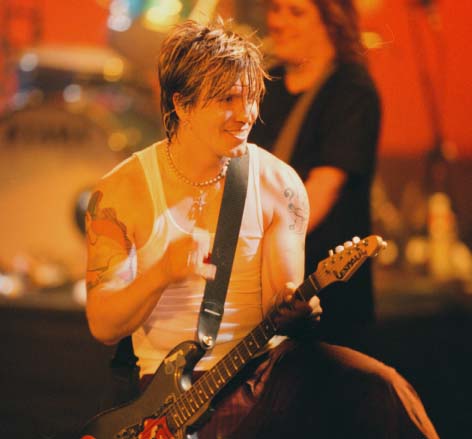
I eventually came up with the verse chords by mistake. I was trying to go from a D to a D/C#, but my finger landed one string too high on an F#, and it seemed like I should go somewhere from there… In a couple minutes I had the rest of the progression.
I immediately went to show Nelson, but his reaction was lukewarm. In fact, he described the progression as “boring.” And I thought, “I’ll show him. These chords aren’t boring, they are pure gold!” Originally, I had strummed the chords, but I rewrote them again as more intricate finger-picking. Now Nelson approved. I had proven that my chords were not boring! Then again, maybe Nelson proved that my chords used to be boring. Either way, if he hadn’t criticized me, I never would have put in the extra work.
These new chords got thrown together with the old chorus chords I had lying around because… well, why not? I wasn’t just going to let them go to waste. I tried for a long time to give the song a bridge, but eventually decided it wasn’t necessary. The song uses only those two progressions.
I guess it’s pretty standard for a song to hit the (vocal) chorus at least three times, and that was my original plan for “Out of Time.” First would be the two choruses you hear, then a short guitar solo over the chorus chords, and the song would end on a repeated loop of the chorus vocal, fading out.
In order to facilitate the fade-out on my demo of the song, I had played the chorus chords over and over at the end. Just fooling around, I tried improvising some guitar melodies over this ending, and started to like what I was doing. I rewound the machine and pressed record. The first take didn’t quite work, as the chords stopped playing before I could squeeze in all the ideas I wanted to record. Rather than make the demo longer, I just tightened up the solo so that I could fit it in. The second take is here (skip to about three-quarters through if you don’t want to hear the boring part). It’s basically what I later recorded on the album.
I immediately fell in love with the idea of ending the song on a solo, and so the third vocal chorus went out the window. But there was still more to be done with the lyrics. As I wrote in an earlier post:
I also started to have second thoughts about my lyrics. A song with a guitar solo this good would need better lyrics than this…
…I figured that something was nostalgic and backward-looking about the sound of the guitar. From that jumping-off point, I fashioned some lyrics that worked sort of in reverse chronological order. The first verse starts in the present, watching the sun rise (on the wrong side of dawn, in fact). The second verse recalls an old friend. The last verse looks back to childhood, when you did stuff just because it was there to be done. Then the last line says there’s no more time for that, but hey…. GUITAR SOLO!!!!!!
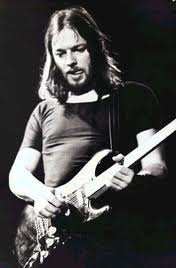
The lyrics are still intentionally plain. I’m not very partial toward flowery language anyway, but I think these are plain even for me. I like to think that, if you just read my lyrics aloud, they’d sound more like regular speech than “poetry.” The last line is very quiet, very resigned to reality: “I could use a little more money. Guess that means I could use a little more work.” I like to think this leads well into the final solo which is, in contrast to the closing words, very big and cinematic. In order to facilitate this, my instruction to Anthony Santoro toward the end of the solo was, “Just be really loud and dramatic. Lots of crashes.” And of course, this again contrasts with the calm, march-like aftermath. The harmonized “oooh”s by Nelson and Karen also add to the intensity. I hope it sounds like a sudden recollection of a really old memory that you thought you forgot… but didn’t quite forget.
Anyway, I’ve probably already over-interpreted my own guitar solo. Never take the writer’s word for what something means, especially in the case of instrumental sections. So don’t just listen to me. Check it out yourself: “Out of Time.”
